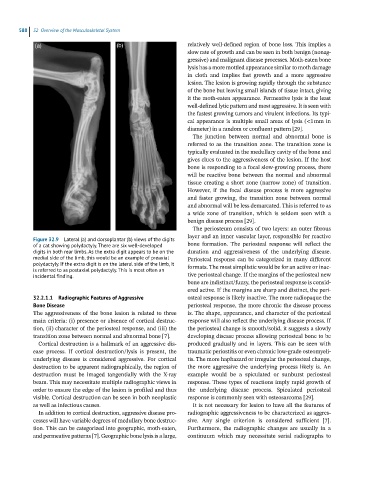Page 574 - Feline diagnostic imaging
P. 574
588 32 Overview of the Musculoskeletal System
relatively well-defined region of bone loss. This implies a
slow rate of growth and can be seen in both benign (nonag-
gressive) and malignant disease processes. Moth-eaten bone
lysis has a more mottled appearance similar to moth damage
in cloth and implies fast growth and a more aggressive
lesion. The lesion is growing rapidly through the substance
of the bone but leaving small islands of tissue intact, giving
it the moth-eaten appearance. Permeative lysis is the least
well-defined lytic pattern and most aggressive. It is seen with
the fastest growing tumors and virulent infections. Its typi-
cal appearance is multiple small areas of lysis (<1 mm in
diameter) in a random or confluent pattern [29].
The junction between normal and abnormal bone is
referred to as the transition zone. The transition zone is
typically evaluated in the medullary cavity of the bone and
gives clues to the aggressiveness of the lesion. If the host
bone is responding to a focal slow-growing process, there
will be reactive bone between the normal and abnormal
tissue creating a short zone (narrow zone) of transition.
However, if the focal disease process is more aggressive
and faster growing, the transition zone between normal
and abnormal will be less demarcated. This is referred to as
a wide zone of transition, which is seldom seen with a
benign disease process [29].
The periosteum consists of two layers: an outer fibrous
layer and an inner vascular layer, responsible for reactive
Figure 32.9 Lateral (a) and dorsoplantar (b) views of the digits
of a cat showing polydactyly. There are six well-developed bone formation. The periosteal response will reflect the
digits in both rear limbs. As the extra digit appears to be on the duration and aggressiveness of the underlying disease.
medial side of the limb, this would be an example of preaxial Periosteal response can be categorized in many different
polydactyly. If the extra digit is on the lateral side of the limb, it formats. The most simplistic would be for an active or inac-
is referred to as postaxial polydactyly. This is most often an
incidental finding. tive periosteal change. If the margins of the periosteal new
bone are indistinct/fuzzy, the periosteal response is consid-
ered active. If the margins are sharp and distinct, the peri-
32.2.1.1 Radiographic Features of Aggressive osteal response is likely inactive. The more radiopaque the
Bone Disease periosteal response, the more chronic the disease process
The aggressiveness of the bone lesion is related to three is. The shape, appearance, and character of the periosteal
main criteria: (i) presence or absence of cortical destruc- response will also reflect the underlying disease process. If
tion, (ii) character of the periosteal response, and (iii) the the periosteal change is smooth/solid, it suggests a slowly
transition zone between normal and abnormal bone [7]. developing disease process allowing periosteal bone to be
Cortical destruction is a hallmark of an aggressive dis- produced gradually and in layers. This can be seen with
ease process. If cortical destruction/lysis is present, the traumatic periostitis or even chronic low-grade osteomyeli-
underlying disease is considered aggressive. For cortical tis. The more haphazard or irregular the periosteal change,
destruction to be apparent radiographically, the region of the more aggressive the underlying process likely is. An
destruction must be imaged tangentially with the X-ray example would be a spiculated or sunburst periosteal
beam. This may necessitate multiple radiographic views in response. These types of reactions imply rapid growth of
order to ensure the edge of the lesion is profiled and thus the underlying disease process. Spiculated periosteal
visible. Cortical destruction can be seen in both neoplastic response is commonly seen with osteosarcoma [29].
as well as infectious causes. It is not necessary for lesion to have all the features of
In addition to cortical destruction, aggressive disease pro- radiographic aggressiveness to be characterized as aggres-
cesses will have variable degrees of medullary bone destruc- sive. Any single criterion is considered sufficient [7].
tion. This can be categorized into geographic, moth-eaten, Furthermore, the radiographic changes are usually in a
and permeative patterns [7]. Geographic bone lysis is a large, continuum which may necessitate serial radiographs to

